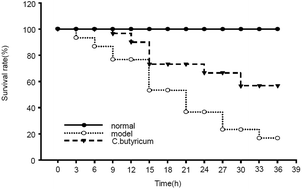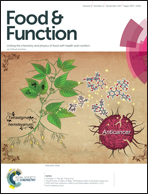The hepatoprotective effect of the probiotic Clostridium butyricum against carbon tetrachloride-induced acute liver damage in mice†
Abstract
Previous studies have revealed that the probiotic Clostridium butyricum (C. butyricum) can attenuate cirrhosis in chronic non-alcoholic liver disease. However, the effects of C. butyricum on acute liver injury (ALI) remain unclear. Therefore, the present study aims to examine the hepatoprotective effects and the underlying mechanisms employed by C. butyricum in a carbon tetrachloride (CCl4)-induced ALI murine model. Here, we evaluated the survival rate and the levels of alanine aminotransferase (ALT), aspartate aminotransferase (AST), anti-oxidants, cytokines and the gut microbiota to elucidate the potential mechanisms by which C. butyricum is hepatoprotective. Our results show that five days of prophylactic C. butyricum treatment significantly reduced mortality by 40% and decreased the CCl4-induced levels of ALT and AST in the serum of these mice. Additionally, prophylactic treatment with C. butyricum increased the activity of both superoxide dismutase (SOD) and catalase (CAT), and substantially reduced malondialdehyde (MDA) levels, which were deteriorated in the untreated ALI mice compared to normal control mice. Furthermore, C. butyricum up-regulated the nuclear factor (erythroid-derived 2)-like 2 (NRF2) content. CCl4-induced mice also exhibited considerable increases of phosphorylation of nuclear factor-kappa B (NF-κB) p65 and pro-inflammatory cytokines, including interleukin-1β (IL-1β), interleukin-6 (IL-6) and tumor necrosis factor-α (TNF-α). However, the inflammatory responses of the liver induced by CCl4 were significantly alleviated by C. butyricum pretreatment. Additionally, we found that interleukin-10 (IL-10), an anti-inflammatory mediator, was increased in the C. butyricum-pretreated group. Microbiota analysis in these mice revealed crosstalk between the gut microbial metabolites and ALI. The intestinal flora was changed by CCl4 administration and was shifted by the probiotic C. butyricum toward more beneficial bacteria, particularly the Clostridia orders, which are the known producers of the anti-inflammatory and anti-oxidative metabolite butyrate. In conclusion, we found that the intestinal flora changes after the intraperitoneal injection of CCl4. We also offer novel insights into the mechanism by which probiotic C. butyricum pretreatment alleviates the CCl4-induced inflammation and oxidative stress of the liver via the modulation of NRF2, NF-κB p65, IL-10 and the intestinal microbiota in mice.



 Please wait while we load your content...
Please wait while we load your content...